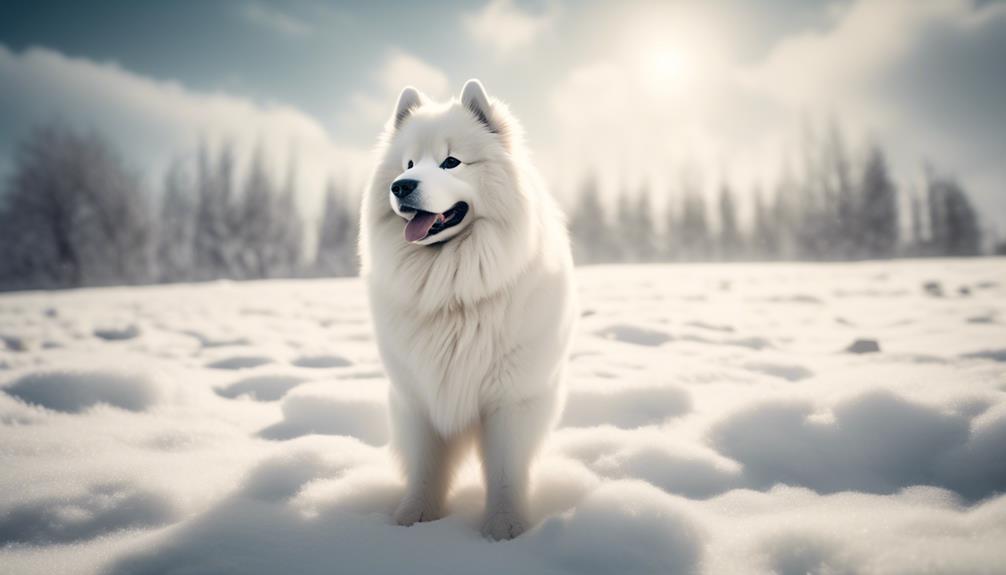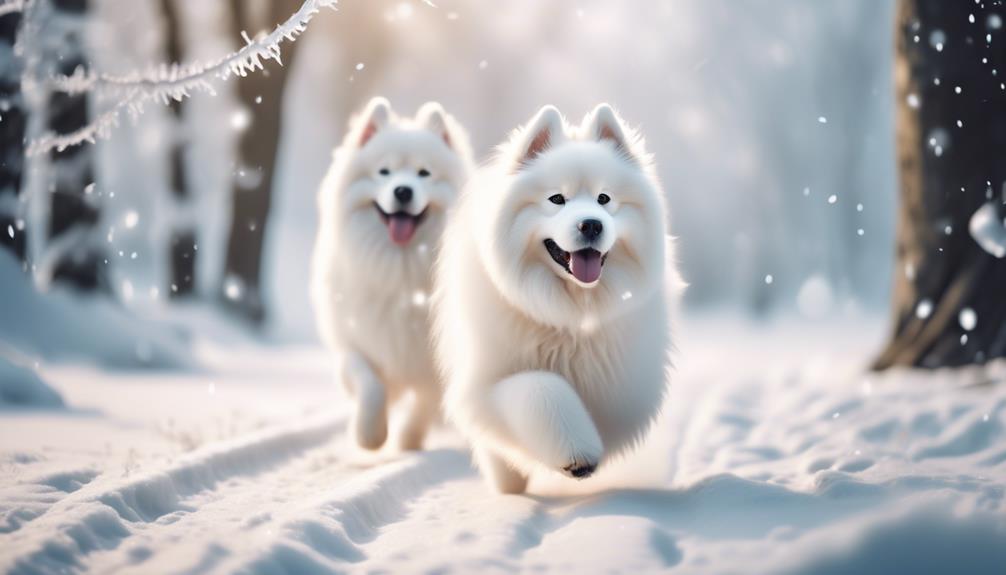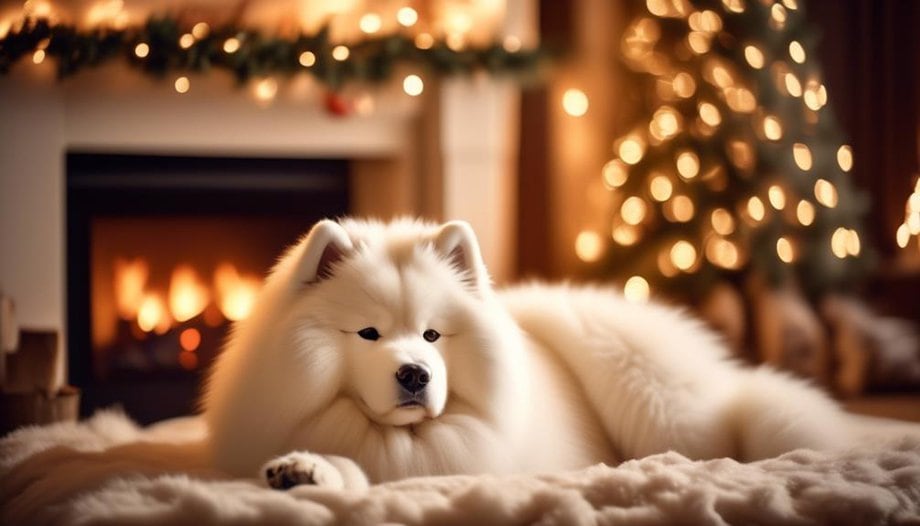What Makes Samoyeds Ideal Dogs for Cold Climates?

Samoyeds are ideal dogs for cold climates due to their thick coat and resilient nature. They can thrive in the harshest of conditions and form a strong bond with their human companions.
Key Takeaways
- Samoyeds have a long history of thriving in cold climates and were originally bred in Siberia for harsh weather conditions.
- Their thick double coats provide excellent insulation, with the underlayer trapping body heat and the outer layer repelling water and ice.
- Samoyeds require access to a warm and dry shelter, as frostbite and hypothermia are primary concerns in cold weather.
- Regular exercise is crucial for Samoyeds during the winter months, and they can be trained for winter sports like sledding or skijoring.
Historical Adaptation to Cold Climates
Samoyeds have a long history of thriving in cold climates, thanks to their impressive adaptation to withstand extreme temperatures and harsh winter environments. Originally bred in Siberia, these dogs were specifically bred to work in the harshest weather conditions. One of the key factors that enable Samoyeds to thrive in cold weather is their thick double coats.
This breed of dog has a unique coat that consists of a dense, insulating undercoat and a longer, water-resistant outer coat. The combination of these two layers helps to keep them warm and protected from the cold temperatures. The thick coat also acts as a barrier against snow and ice, allowing the Samoyeds to continue working effectively even in freezing conditions.
In addition to their thick coat, Samoyeds have other physical and behavioral traits that contribute to their ability to adapt to cold climates. They have a compact and sturdy body structure, which helps to conserve body heat. Furthermore, their high energy levels and strong work ethic make them well-suited for the physically demanding tasks required in cold weather environments.
Double Coat for Cold Weather

The double coat of Samoyeds, consisting of a soft and thick underlayer and a longer, harsh outer layer, provides excellent insulation against cold temperatures and repels water and ice to keep them dry in cold weather. This unique combination of fur makes Samoyeds well-suited for cold climates and the winter season.
Here are three reasons why the double coat is essential for Samoyeds to stay warm in even the most extreme conditions:
- Excellent Insulation: The thick fur of the underlayer acts as an insulating barrier, trapping body heat close to the skin and preventing it from escaping. This helps Samoyeds maintain a comfortable body temperature, even in freezing temperatures.
- Repels Water and Ice: The outer layer of the double coat is longer and harsher, serving as a protective shield against moisture. It repels water and ice, keeping the Samoyeds' underlayer dry. This helps prevent the fur from becoming wet, which would lead to loss of insulation and discomfort in cold weather.
- Dense Fur: The double coat of Samoyeds is dense, with an abundance of hair follicles per square inch. This density provides an additional layer of protection against the cold by trapping air close to the body. The air acts as an insulator, further enhancing the coat's ability to keep Samoyeds warm in chilly conditions.
Safety and Health Considerations

To ensure the safety and well-being of Samoyeds in cold climates, it's crucial to understand the necessary safety and health considerations. Samoyeds are a breed well-suited for winter conditions due to their thick and dense double coat, which provides insulation and protection against the cold. However, despite their natural ability to withstand cold weather, Samoyeds are still susceptible to certain health issues in extreme cold temperatures.
One of the primary concerns in cold weather is frostbite and hypothermia. Samoyeds should have access to a warm and dry shelter that protects them from the cold elements. Proper shelter should be insulated and provide adequate space for the dog to move around comfortably. Monitoring the signs of cold-related health issues, such as shivering, lethargy, and pale or discolored skin, is crucial. If any of these symptoms are observed, immediate veterinary attention should be sought.
Additionally, Samoyeds may require increased calories in colder weather to maintain their body temperature. Feeding them high-quality dog food that's rich in proteins and fats can help provide the necessary energy for warmth. Regular exercise is important for Samoyeds in winter, but it should be appropriate to prevent overexertion. It's also important to check for ice and snow accumulation on their paws and coat to prevent discomfort and injury.
Nutritional Needs in Cold Weather

In colder climates, it's important to consider the nutritional needs of dogs such as Samoyeds to help them maintain their body heat and overall health. Samoyeds, originally used for sledding and herding reindeer in cold climates, are well-adapted to the winter months. To ensure they stay healthy and active during this time, they need regular and proper nutrition.
Here are three important factors to keep in mind when it comes to the nutritional needs of Samoyeds in cold weather:
- Increased Caloric Intake: Samoyeds may require additional calories in colder weather to maintain their body heat. The energy expended to keep warm can be significant, so providing them with extra calories can help them stay warm and active.
- High-Quality Dog Food: A diet rich in proteins and fats is beneficial for Samoyeds in cold climates. These nutrients provide the necessary fuel for their bodies to generate and retain heat. High-quality dog food formulated for active breeds is recommended to meet their nutritional needs.
- Monitoring and Adjusting Food Intake: It's important to monitor a Samoyed's weight and adjust their food intake based on their activity levels. Regular exercise, such as playing in the snow, is essential to keep them mentally stimulated and physically fit. Adjusting their food intake accordingly ensures they receive the right amount of nutrition to support their energy levels.
Exercise in the Winter

Regular exercise is crucial for Samoyeds during the winter months to maintain their health and happiness while embracing the cold climate.
Samoyeds, known for their stunning white fur, are a breed of dogs that love winter and are well-equipped to stay warm in the cold. Like their relatives, the Siberian Huskies, Samoyeds have webbed feet that make them excellent at pulling sleds. This unique trait allows them to navigate the snowy terrain with ease, making them perfect companions for winter sports such as skijoring or dog sledding.
However, it's important to avoid overexertion and take necessary precautions when exercising Samoyeds in cold conditions. While they enjoy outdoor activities, it's crucial to ensure that they don't overheat or get frostbite. After winter exercise, it's essential to check their paws and coat for ice and snow accumulation, as this can cause discomfort and potential health issues.
Engaging in appropriate winter exercises not only helps Samoyeds stay active and stimulated, but also promotes their overall well-being during the winter months.
Grooming and Coat Care in Winter

Maintaining the health and insulating properties of a Samoyed's double coat is crucial during the winter months. These great sled dogs, originally bred for herding and working in harsh Arctic conditions, have a thick, weather-resistant coat that helps protect them from the cold.
Here are three important aspects of grooming and coat care for Samoyeds in winter:
- Regular brushing: Samoyeds have a dense, fluffy undercoat that helps insulate them. Regular brushing not only removes loose fur that can impede insulation, but it also helps prevent matting, which can lead to skin and coat problems. Brushing should be done at least once a week, and more frequently during heavy shedding periods.
- Pay attention to the paws and coat after outdoor activities: Samoyeds love to spend time outdoors, especially in snowy conditions. It's important to check their paws for ice and snow accumulation, as this can cause discomfort and even frostbite. Additionally, inspect their coat for clumps of ice or snow and gently remove them to prevent matting.
- Avoid frequent washing: Samoyeds have a self-cleaning coat that helps maintain its natural insulation properties. Frequent washing can strip the coat of its natural oils and disrupt this self-maintenance ability. Instead, focus on regular brushing to keep the coat clean and healthy.
Creating a Comfortable Indoor Environment

To ensure the well-being of your Samoyed during the winter months, it's essential to create a comfortable indoor environment that provides warmth and protection from harsh cold weather. Samoyeds make great family pets and love playing and spending time with their owners. Their ability to stay active and energetic even in cold conditions makes them great companions for outdoor activities. However, when it comes to winter weather, their fluffy white coats require extra care to keep them comfortable.
One of the first steps in creating a comfortable indoor environment for your Samoyed is to ensure your home has adequate heating. Maintaining a warm temperature is crucial for their well-being. Additionally, providing cozy bedding, like dog beds or blankets, offers insulation and comfort, making them feel safe and secure indoors.
Dry air can be harsh on your Samoyed's skin and coat, so using a humidifier is recommended. This helps to maintain proper moisture levels and prevent dryness. Sealing windows and doors is also important to avoid drafts. By creating a cozy and draft-free space, you're ensuring your Samoyed's comfort during the winter months.
Lastly, it's important to provide access to a warm and comfortable indoor space, especially during extreme cold weather. This will allow your Samoyed to seek shelter when needed and protect them from the harsh elements. By following these tips, you can create a comfortable indoor environment for your Samoyed, making every day enjoyable for both you and your furry friend.
Frequently Asked Questions
Can Samoyeds Handle Cold Weather?
Samoyeds can handle cold weather due to their dense double coat, which provides insulation and repels water and ice. Owners should be vigilant for signs of frostbite and hypothermia and ensure proper winter care, including grooming, exercise, and nutrition.
Can Samoyed Live in Warm Climates?
Samoyeds can adapt to warm climates with proper care and cooling methods. However, they may face challenges due to their heat tolerance and thick coats. Grooming, exercise, shade options, hydration, and suitable living conditions are important for their well-being.
What Temperature Should a Samoyed House Be?
The ideal temperature for a Samoyed house in cold climates is between 65-75°F. Maintaining a comfortable indoor temperature is crucial for keeping Samoyeds warm and preventing health risks like hypothermia. Their thick coat helps them tolerate colder temperatures, but precautions should still be taken.
What Dog Breed Can Handle the Coldest Weather?
Samoyeds and Huskies are among the dog breeds known for their ability to handle the coldest weather. Their anatomy, such as dense double coats, helps them stay warm. Proper shelter, winter essentials, and training are important for their safety and well-being in icy conditions.









